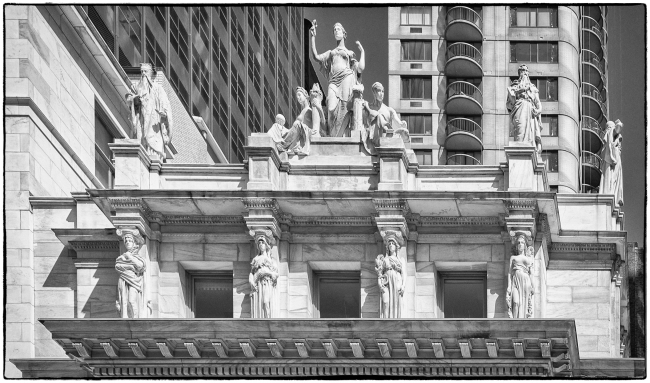According to Wikipedia:
The limestone Beaux-Arts courthouse, in the style of an 18th-century English country house, was designed by James Brown Lord and built in 1896−1899. It is considered to be an “outstanding” example of the City Beautiful movement. Some 25 percent of the cost was spent on sculpture, a huge sum at the time. At the time of its construction, the American Architect and Building News predicted that “the rest of the country will envy New York the possession of this building.” In 1900, Charles DeKay wrote in The Independent that the courthouse “shines like an ivory casket among boxes of ordinary maple.”
The exterior features sculptures in white marble on subjects related to law. Karl Bitter’s Peace is the central grouping on the balustrade by Madison Square. Daniel Chester French’s Justice is the central grouping on 25th Street. Justice is flanked by Power and Study, also by French.
Sixteen sculptors worked on the courthouse, all members of the then-newly formed National Sculpture Society. In 1928, The New Yorker called the building “the rather pleasant little Appellate Court House with its ridiculous adornment of mortuary statuary.”
Charles Henry Niehaus’s Triumph of Law, described as a “giant pedimental group” on “a screen of six Corinthian columns, rising from several groups of allegorical sculpture,” fronts 25th Street. Thomas Shields Clarke sculpted screen of female caryatids on the Madison Avenue front, at the third-floor level, representing the seasons; Summer holds a sickle and a sheaf of wheat.
On the roof, there are single standing figure sculptures, depicting historical, religious, and legendary lawgivers. These statues are of the same height and proportion, are robed, and appear with various attributes associated with the law, such as book, scroll, tablet, sword, charter, or scepter. The first statue on the Madison Avenue side is Confucius by Philip Martiny, with Peace by Karl Bitter in the middle, and Moses by William Couper at the other end. Facing south on the 25th Street side is Edward Clark Potter’s Zoroaster, which was along with all 25th Street statues moved down one bay when Charles Albert Lopez’s Mohammed was removed in 1955, following protests against this image of the prophet from Muslim nations. Next on this side is Jonathan Scott Hartley’s Alfred the Great, followed by George Edwin Bissell’s Lycurgus and Herbert Adams’s Solon. Next to Solon is the Justice set of sculptures by French (described above), and then three more statues: John Talbott Donoghue’s Saint Louis, Henry Augustus Lukeman’s Manu, and Henry Kirke Bush-Brown’s Justinian. At street level, “two pedestals holding two monumental seated figures” of Wisdom and Strength by Frederick Ruckstull (born Ruckstuhl) flank stairs leading to a portico.
The exterior of the building was designated a New York City landmark in 1966.

